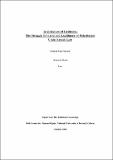| dc.contributor.advisor | Cavanaugh, Kathleen | |
| dc.contributor.author | Abu Hussein, Hadeel | |
| dc.date.accessioned | 2017-02-01T15:36:57Z | |
| dc.date.issued | 2016-10 | |
| dc.identifier.uri | http://hdl.handle.net/10379/6278 | |
| dc.description.abstract | This research focuses on land law and provides an overview of the right to land under international law, followed by a background of the Israeli/Palestinian conflict. Subsequently, exploring the underpinning of the land regime in Israel, while focusing on land expropriation and forced housing eviction.
The land is one of the core resources of human existence, development and activity. Therefore, it is a basis of political power of social and economic status. Land regimes and planning regulations play a dynamic role in deciding how competing claims over resources will be resolved. According to the legal geography theory, law and space are significant aspects of one another, and they examine, among other things, how spatial ordering impacts legal regimes and how legal rules form social and human space. How did the law shape the development of social and political space? Examining the state of Israel provides an example for ‘filling the gaps and silences in dominant historical narratives, and understanding of the historical background to the creation of the legal system towards empowering the ideologically strong nationalism domination of one ethnic group’. This superimposes a Jewish space into the state space and attempts to minimise those associated with the Palestinian presence.
Against this backdrop, this research endeavours to understand the spatial strategies adopted by Israel to organise the entire territorial expanse of the country as Jewish, while excluding Arab Palestinian citizens of Israel and residents of East Jerusalem from the landscape. The Examination of Israel land regimes’ is necessary to highlight the events occurred to land belonging to the Palestinians as a result of the 1948 war and, later, the 1967 Six-Day War. In which cause this systematic nature of marginalisation, which is mapped out in various ways across the civil, political, and socio-economic landscape. | en_IE |
| dc.rights | Attribution-NonCommercial-NoDerivs 3.0 Ireland | |
| dc.rights.uri | https://creativecommons.org/licenses/by-nc-nd/3.0/ie/ | |
| dc.subject | International law | en_IE |
| dc.subject | International human rights law | en_IE |
| dc.subject | International humanitarian law | en_IE |
| dc.subject | Land law | en_IE |
| dc.subject | Human rights | en_IE |
| dc.subject | Forced houses eviction | en_IE |
| dc.subject | Land expropriation | en_IE |
| dc.subject | Israel/ Palestine conflict | en_IE |
| dc.subject | Jerusalem | en_IE |
| dc.subject | Arab Palestinians in Israel | en_IE |
| dc.subject | Discrimination | en_IE |
| dc.subject | Law | en_IE |
| dc.title | Architecture of exclusion: the struggle for land and legitimacy of Palestinians under Israeli law | en_IE |
| dc.type | Thesis | en_IE |
| dc.local.note | The thesis focuses on land law. It provides an overview of the right to land under international law, followed by a background of Israel/Palestinian conflict, and then turns to an extensive examination of the exclusion of Arab-Palestinian citizens of Israel, through a detailed review of the land regime in Israel. | en_IE |
| dc.description.embargo | 2021-02-01 | |
| dc.local.final | Yes | en_IE |
| nui.item.downloads | 2261 | |


